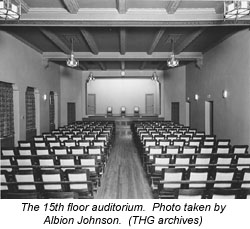Telecommunications History Group Resources
931 14th St. Historic Building
15th Floor - Building Tour
 Today this top floor contains conference rooms, a small lunch concession and a large break room. In 1929, the break room space contained the auditorium, used for employee meetings, motion picture demonstrations, amateur theatricals, social gatherings and entertainment.
Today this top floor contains conference rooms, a small lunch concession and a large break room. In 1929, the break room space contained the auditorium, used for employee meetings, motion picture demonstrations, amateur theatricals, social gatherings and entertainment.
Today, the break room has tables and chairs partitioned in groups by low walls using the iron teller cages or pay stations from the first floor 1929 business office. The original black hammered iron light fixtures remain, as does the decor of the electrical symbols used on the ceiling. Historical photographs by Albion Johnson hang on the walls.
In 1929 the fifteenth floor also housed the remaining offices, occupied by the general department heads.
Sidebar: Johnson’s Photographs
Albion Johnson was a company employee and an accomplished photographer. Johnson was the chief draftsman among several hundred employed at the time, as well as an extraordinary photographer. He built his own cameras and was the inventor of a darkroom timer and a circular slide rule to scale photographs for cropping. The quality of these large photographs is outstanding. Everything is in crisp focus because he used a pin-hole camera technique. If exposed through a pin hole everything is in focus.
But wait … there’s more! Actually, there are two more “floors” to this building. These aren’t complete floors, however, and in fact they barely exist at all. On top of the building are four towers and a “penthouse.” The “penthouse” housed elevator equipment for all the elevators in the building. These elevators were state-of-the-art in 1929; they traveled at 700 feet per minute and were fully automatic. In 1929 this was a big deal; in fact, the phone company placed operators in them just to reassure employees that the contraptions would work!
At least one of the towers eventually contained equipment to control and monitor the microwave system on the roof. This microwave system was not for cooking; phone calls were sometimes transmitted through microwave systems (see our long distance section for more information).
One tower wasn’t really a set of floors at all–it was a cleverly disguised water tower! In 1929 this tower provided the water for the building; now, it merely provides any water needed by the fire control systems.
